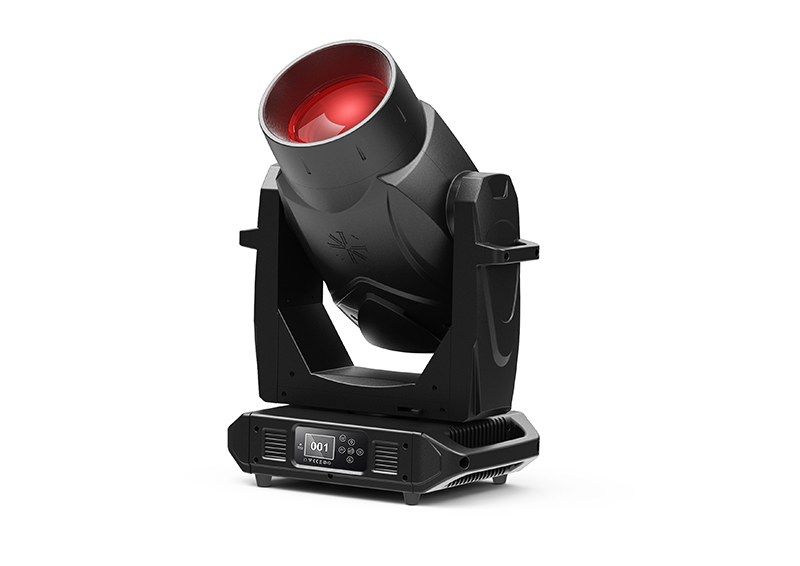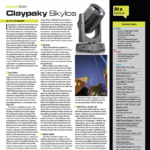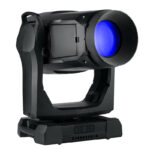
Beam lights, as a category we are all familiar with, have undergone radical evolution over their last few iterations. Initial designs were limited in zoom range, typically had poor (or no) color-mixing capability, and were mainly for projecting pencil-thin beams with peaky brightness profiles over vast distances. Defaulting to the oft-used “fingers of God” unadorned multi-beam look now seeming, if not passé, then at least lacking in imagination, makers of lights have imagined up new tricks for designer’s bags. In improving their optics, adding features like better zooms and prisms, they continue to shorten the gap between traditional large-format hard-edged fixtures and the newer class of beam luminaire. One such fixture, from one such company, Vari-Lite, is the VL10 BeamWash, which we are looking at today.

Light Source
As with several lights in the same class, the VL10 uses a super short-arc Philips 550W 25R lamp that comes pre-focused in its housing, similar to lamps used in projectors. Short-arc lamps of this variety have demanding cooling requirements. Lacking an external envelope makes them very sensitive to temperature changes in the surrounding air. One of the solutions Vari-Lite has come up with to address this is to mount one of the lamp housing fans on a motor — it moves on a linear actuator to direct cooling air to where it is needed most. Lamp change is finicky — there are non-captive screws to be removed, and this lamp is not intended to be changed while hanging in a rig.
Immediately following the lamp and hot mirror are the dimmer blades. These close across the beam like a pair of scissors, with a bit of frosted glass on the leading edge to help smooth the dimming out a bit. The resulting dimmer curve was slightly deeper than an ideal square law curve, and the dimming was reasonably smooth. I did see some minor artifacts in the beam at the very low end, but I would not expect this to be an issue for the intended applications of this luminaire. Certainly, the lamp has the punch that we’ve come to expect from these increasingly-powerful short-arc lamps: I measured 60,120 lux at 50 percent zoom at five meters at the center of the beam. The dimmer blades are also used for strobing, and the usual array of expected strobe effects is present here.

Color Mixing
Following the dimmer flags is the color mixing module. The VL10 has three color-mixing flags, which interestingly only enter the beam from one side of the light instead of the usual “curtain” style with opposing flags. I suspect this decision was made to make the best use of space within the somewhat cramped interior of the light, and color mixing was reasonably smooth across the beam and projected circle of light. Vari-Lite has gone with a somewhat unsaturated cyan in this light, which results in weak mixed blues. Conversely, the magenta is deeply saturated, and the mixed reds were quite strong. Vari-Lite tells me this was their solution to balance the need for deeper colors while not straying too far from previous product lines. Philips specifies this lamp as having a native color temperature of 7,000 Kelvin; my meter read an output temperature of 6,300K once the light passed through all the internal optics. The fixture has a fixed color wheel to help with hard-to-mix colors, though it’s on the next module in line instead of the color module. Included there are the requisite red and deep Congo blue/UV filters, and a CTO filter that knocks the CCT down to around 2,700K. These filters are glued in place and not intended to be user-replaceable. Adjacent colors work well together and produce usable split colors. The fixed color wheel is also very snappy and should produce some good color effects.
Effects and Gobos
Next in line is the effects module, which has the aforementioned fixed color filters, the gobos, and what Vari-Lite calls the “VL*FX” system. This is a system of what are essentially large rotating gobos, but instead of centering the gobo over the aperture, the glass discs are offset from the center like an animation wheel, with only a small portion of the disc visible at any given time. Unlike an animation wheel, which typically rides on its own armature and of which there are usually only one, the VL*FX wheel has four pattern positions plus open, all of which rotate and index, as well as twists, shaking, and a steppy 8-bit-looking movement. The VL*FX system is interesting and unique — having what are essentially four animation wheels adds an intriguing level of functionality, one I haven’t seen on any moving light thus far. A diversity of patterns along with the offset rotation gives designers a new tool to use in creating unique and interesting effects, a welcome innovation in intelligent lighting.
This module also houses two more traditional gobo wheels, a rotating and indexing wheel with eight patterns plus open, and a fixed gobo wheel with 12 positions plus open, four of which are aperture reduction holes for getting a pencil-thin beam. Somewhat unusually, the rotating gobos are (and must be) metal, as glass gobos of this size would be incapable of withstanding the extreme heat. Only the rotating gobos and VL*FX wheels are interchangeable; the fixed gobo wheel is stamped steel. Gobos are all clearly geared toward aerial effects, though the VL*FX wheels could stand in as breakups in the right usage contexts.
Zoom, Focus and Movement
Last before the final output lens are the zoom and focus lens groups, prisms, and frost. The VL10 includes two prisms, an eight-facet circular prism, and a four-facet linear prism. Both have good image separation, are indexable and rotatable, and can be overlaid for some interesting effects. Two frost filters are also here — a softer frost that acts more like a gobo softener, leaving the edges of the image intact, and a much heavier frost that essentially turns the output into a wash. As both the prism and frost armatures occupy the same plane perpendicular to the lamp, they cannot be used simultaneously. Zoom adjusts smoothly, from 2.2° to 48°, and can cover its range in approximately 0.4 seconds, a respectable speed for such a wide range.
Pan range is 540°, and tilt is 270°, and the fixture covers these ranges in approximately 2.75 and 1.5 seconds, respectively. A full fixture recalibration takes 41 seconds, and the light begins outputting before the homing process is complete, so be aware of this when resetting it during a show. It weighs 33kg (72 pounds) and has a base 462mm (18 inches) by 501mm (19 inches) and stands 704mm (27 inches) tall. Power in is via Neutrik PowerCON TRUE1 power ins, and the fixture is rated for a maximum draw of 850W at full tilt. DMX in is via standard 5-pin XLR ins and pass-throughs and also accepts Art-Net data via an RJ-45 input, and there are software upgrades planned for allowing additional protocols. On the front face of the base is the menu system for setting address and light options, and tilt and pan locks secure the light for transport.
At A Glance:
Not LED-Based, Yet Intriguing
It’s rare these days that I review a light that isn’t LED-based, and this is an exciting one. The VL10 BeamWash is a fascinating combination of power and high-quality effects, and represents the next step in the evolution of small yet high-power effects lighting. The VL*FX system is a welcome new addition to the visual toolbox of designers, and all of this in a fairly compact package that draws less than 1000W.
VL10 BeamWash
PROS
Bright, nimble, and the VL*FX set of wheels add a new dimension of visual effects.
CONS
Cyan wheel could use more saturation.
SPECS:
Light Source: Philips 550W 25R
Lamp Wattage: 550W
Fixture Wattage: 850W (at full)
Zoom: 2.2° to 48°
Color: CMY + fixed wheel
Gobos: One rotating, one fixed
Size: 18” x 19” base, 27” tall
Weight: 72 lbs.
MSRP: $11,665
CONTACT
Manufacturer: Philips Lighting/Signify
More Info: http://lighting.philips.com



